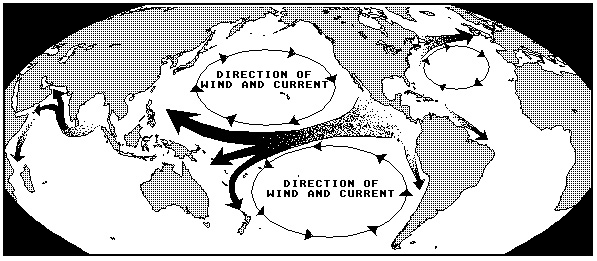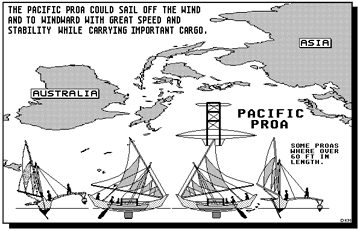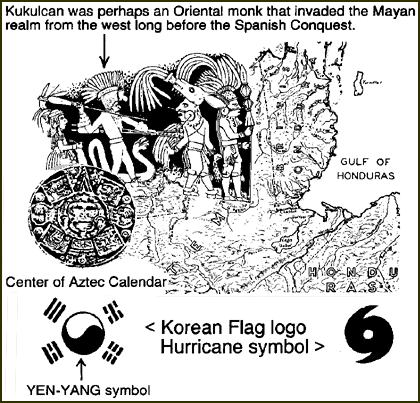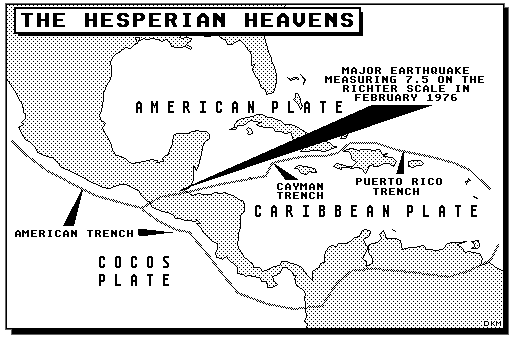spiritofatlantis.com | Duane K. McCullough

Direction of natural pathways and migratory routes.
Although the subject of Atlantis is primarily a seafaring story about our trans-Atlantic maritime heritage,
it is also a topic about nautical migrations and how our New World ancestors
colonized the shores of eastern and southern Asia by sailing across the Pacific Ocean.
V3
Chapter 2: Follow the Sun
1/ Every since the "New World" was found by
seafarers from the "Old World", historians have
consistently under estimated the cultural achievements of
American human history, for example: Anthropologist have assumed
for many generations that the native human inhabitants of the New
World came from the Old World by walking across the ice near the
Bering Sea during the last ice age because the mongol features
found in both the "older" East Asian region and the
"newer" New World natives are similar - therefore,
according to conventional calendrical history, American human
history - and any creative artwork, evolved from Old World
"oriental" history.
(The fact that mongoliod features are found in humans throughout
the Pacific Realm does not necessarily mean that they, as a
separate "variety" of humans, originated within East
Asia)
2/ Is it possible that the mongol race of humans originated in
the New World and nautically ventured across the Pacific Ocean to
the Orient - via Polynesia, Melanesia, Micronesia and Indonesia?
(Much of early anthropological literature is written from a
land-lubber's perspective - which consisently undermines the
nautical achievements of ancient maritime cultures, such as the
seafaring ability to voyage over vast distances)
3/ Only now are professional historians beginning to realize
the navigational skill of the trans-Pacific native and their
remarkable seafaring abilities.
4/ With their fast multi-hull canoes, some of which were over
sixty feet in length, they sailed the waters of the Pacific Ocean
almost as if it were an inland sea.
(A crew member aboard Captain Cook's ship in the Pacific once
documented certain native canoes were so fast that they sailed
rings around Cook's ship while they were traveling at eight knots
"with the same ease as if we were at anchor")

Sailing west across the Pacific Ocean.
With speeds as fast as modern sailboats, ancient Pacific Proas and catamarans, once sailed vast distances between Pacific Islands.
5/ Both the Tahitian catamaran and the Polynesian/Malaysian "flying proa"
employed a mast and sail configuration almost identical to the Phoenician lateen rig.
(Imagine the primordial desire of the Pacific mariner to sail
toward the setting sun to satisfy the human curiosity of where
the sun goes every day, and realize how easy it is to understand
the western "down-wind" migratory path of island
hopping across the Pacific Ocean)
6/ Even the successful Kon-Tiki expedition led by Thor
Heyerdahl proved that New World natives were capable of
"drift sailing" to Polynesia aboard balsa rafts with
simple square sails.

The Trans-Pacific Connection.
If one compares the pre-Columbian artwork of Middle America with ancient Oriental artwork, it becomes apparent
that the style of certain items are almost identical - therefore, because the major navigable currents of the tropical Pacific
run from the New World to the Old World, perhaps much of the cultural history of the Orient is based on ancient stories
from the New World continent of Atlantis.
7/ It is very likely that since the prevailing wind and water
currents of the tropical Pacific Ocean run from east to west,
prehistoric natives sailed from Middle America to the orient long
before any oriental sailors were capable of reaching the New World
by way of the north Pacific realm.
(There is growing evidence that a fleet of Sino-Korean ships
"discovered" the New World and influenced the Nahuatlan culture of the
Zapotec and Toltec tribes - in fact, the Yen-Yang symbol
(also known as the Tai-ki ideogram),
which is found on the Korean flag, has also been discovered in
stone at the Mayan site of Copan, Honduras)
[Since the Yen-Yang symbol looks very much like the
"hurricane symbol" found carved on rocks in places such
as Cuba, perhaps the "great one-legged wind-god" of the
Toltecs, known as "Jurakan", and the ancient
Sino-sailors of Korea or Japan were somehow related]
8/ Perhaps much of the art and science associated with
oriental Asia can be traced to prehistoric Middle America -
perhaps sun following sailors from the New World brought to
oriental Asia certain social customs and religious beliefs, like
the Buddha system of philosophy and ethics.
(There exists an "interesting coincidence" in which the
mother of Gautama Buddha was known as Maya, and the first name
given to the Mayan region of Middle America was
"Guatemala")
9/ Could the Mayan culture have anything to do with the
building of an ancient shrine at Miya-Jima near Hiroshima in what
is now Japan?
(The Miya-Jima shrine is dated to the same time period in which
Sino-seafarers embarked to the east in "junk ships" to
answer tales of treasure "beyond the sunrise")
10/ Is it merely a "numerical coincidence" that the
Mayan counting system and the Indo-Oriental counting device,
known as the Abacus, share the same quintuplet unit value of five
when calculating "bars" and "beads"?
(According to early mathematical concepts among ancient cultures,
the unit value of the number "0" (zero) was known by
Mayan mathematicians centuries before it was ever realized by any
Old World merchants)
[Regge music is also based on a syncopated five-tone number scale
and is found throughout many ancient maritime cultures -
particularity on the Caribbean isle of Jamaica]
11/ Another prehistoric trans-Pacific "coincidence"
can be found by comparing the similarity of an ideographic
alphabet from Easter Island in the southern Pacific to that of a
character script system found "down-stream" in the
Indus Valley of India - wherein the vowel letters of "I,O
and U" exist adjacent to a human figurine holding the
symbol.

According to conventional Greco-Roman mythology, the Hesperian Heavens could be found in the "far
western realm" - where the daughters of Atlas grew "the golden apples of youth" in a wondrous garden that was
protected by a dragon-like apparition.
If Atlas, the Titan seafarer and grandson of Oceanus, was ever a real person that lived in a garden seaport
located in the western Caribbean Sea on a unstable fault-line, then perhaps Plato's sea-story about a lost place in the western
Atlantic named Atlantis is a true account of our maritime heritage.
12/ Is it possible that the Sumerians of the Middle East were
the cultural result of sailors from the New World who sailed long
ago the summer winds across both the Atlantic and Pacific Oceans
only to meet each other half way around the globe on what is now
the Arabian peninsula?
(While the Mesopotamia in the Middle East may represent the
"Cradle of Civilization" - the Caribbean Basin of the New World can be considered the
"Crib of Humanity")
Return to the Volume 3



